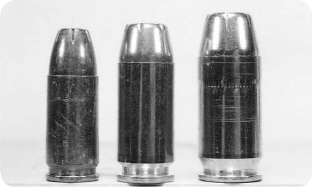
It doesn’t matter how cheaply you can reload 9mm, .40 or .45, you can’t shoot it as cheaply as you can the .22 Long Rifle.
The only way to get good at shooting your Glock is to shoot. The more you do, the better you get. The only drawback to practicing is cost. Ammo can be frighteningly expensive. If you’re running a G-17, then the cost of 9mm “surplus” ammo used to be quite reasonable. However, if you’re shooting a Glock chambered in 10mm or .357, the cost of ammo can bring tears to your eyes.
There is a solution. Every year, the ammunition manufacturers create “billions and billions” of rounds that solve your problem. The round in question? The lowly .22 Long Rifle. Even “surplus” 9mm costs money. At a cost of $120 per thousand rounds (current reasonable retail price; things may change by the time you read this), 9mm costs $6 per box of 50 rounds. If you shop around, you can find .22LR on sale at one of the big box discount stores for $1 a box of 50 rounds. Even if you spend $1.50 for that box, and score surplus 9mm ammo dirt cheap at $5 a box, the $3.50 difference can add up.
You will probably never see a Glock rimfire pistol. The import points system is too great a hurdle, as the Glock rimfire would have the dual problem of gaining no points for being so small, and losing points from being a blowback pistol. Could Glock do it? Sure, by making the whole thing here in the United States. (Don’t hold your breath.)
Advantage Arms makes a rimfire conversion kit that simply replaces the upper assembly of your Glock. They offer five models, one to fit all Glocks from the G-17/G-22 as well as the big-frame 10mm/45s and the compacts. At a minimum. of $3.50 per box difference in price, you won’t have to shoot a thousand rounds to pay for the conversion. And once it’s paid for, the rest is gravy.

It doesn’t matter how cheaply you can reload 9mm, .40 or .45, you can’t shoot it as cheaply as you can the .22 Long Rifle.
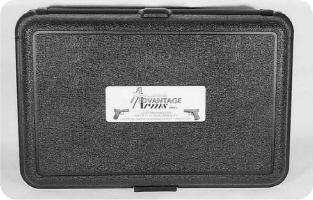
The Advantage Arms .22 conversion kit comes in its own carry case.
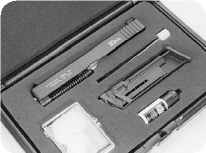
Inside the case are the conversion unit, cleaning rod and supplies, and a 10-round magazine.
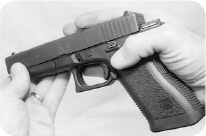
To switch your Glock to a .22, simply dry-fire and remove the slide assembly. All you’ll need next is the assembled frame.
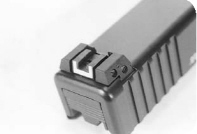
The law enforcement model of the Advantage Arms conversion comes with the new Glock adjustable sight.
The Advantage Arms conversion is a complete upper assembly. The slide is machined from aluminum, so it will be light enough for the relatively wimpy .22 LR to blow it back and cycle the pistol. To change, simply check your Glock to make sure it is unloaded, dry fire it and remove the upper from the receiver. Then slide the Advantage Arms conversion on as if it were simply another Glock slide assembly. One small detail to be aware of is that the Advantage Arms conversion has an ejector that is hooked on the barrel, and does not use the ejector buil into your Glock. If the Advantage ejector isn’t properly assembled onto the barrel, the conversion will not work. It probably won’t fit. Advantage Arms even went so far as to include a firing pin safety in the conversion slide, so just like your centerfire Glock upper, the Advantage Arms-equipped pistol will not fire if dropped.
The magazine for the Advantage is also a neat bit of engineering. Rather than reinvent the rimfire magazine, they simply used an existing design and encased it in a plastic housing to fit the Glock magazine well. As a result, you have a fat plastic magazine that only holds 10 rounds. (I can’t imagine the hassle of trying to come up with a magazine that not only held more than 10 rounds of rimmed rimfire cartridges, but also did not extend below the frame.) And they are still $25 each, even six years after the first book, a reasonable price to feed your shooting habit with cheap ammo.
The magazine feeds well, and Advantage has gone to the trouble of testing it with many different types of ammo. The ones they recommend, and with which it works best, are CCI MiniMags, Remington Golden bullets, Remington Thunderbolt. Many other brands of 40-grain high velocity .22LR ammo work well too. Since I had lots of Remington Golden ammo on hand, that was what I used in it for an afternoon to testing. Five hundred rounds later, I was out of ammo, every clump of dirt on the range had been dealt a devastating blow, I had a bunch of empty rimfire brass to pick up, and the conversion had not failed at all.
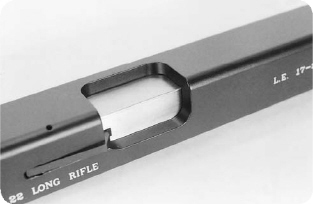
The Advantage Arms conversion barrel, being a blowback, doesn’t lock to the slide.
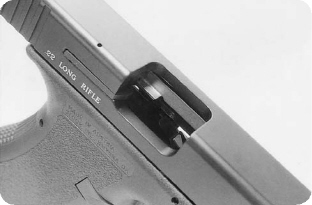
The conversion has its own ejector and doesn’t rely on the one already in your Glock.
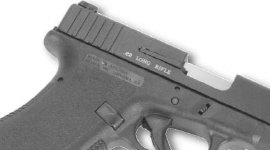
Once installed, the conversion has the same size as a standard Glock, but its aluminum slide makes it a bit lighter overall.
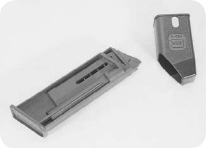
The Advantage Arms conversion magazine is a magazine tube in an adapter to fit the Glock’s magazine well. It comes with a modified Glock magazine loader to make charging the .22 magazine easier.
Also, the magazines lock open when empty. So many rimfire pistols do not, and most conversion units will not lock open when empty.
Accuracy? Well, besides being more accurate in the plinking sessions than the Glock had been with centerfire ammo, I don’t know. The purpose of a conversion kit is not to try and shoot Bullseye with it, but to provide inexpensive practice. Oh, it is plenty accurate enough for even club-level target shooting, but that isn’t why I’d have one.
On disassembly, I ran into a problem, and then read the instructions. (Even gunsmiths sometimes skip the instructions, even those who advise others to read them first.) Since the slide does not move the barrel, pulling back the slide to disassemble the conversion kit doesn’t work. Here’s the drill: After you check to make sure it is unloaded, dry fire to release the firing pin. Then press the barrel back slightly to release the locking lever. You can do it by pressing the muzzle against a surface, like the shooting bench with a towel over it.
Once the barrel is back, you can press the slide lock latch down to then remove the slide. Once you do it a couple of times you’ll get the hang of it.
Depending on where you get yours and the options you get, the Advantage Arms conversion kit can be yours for right around $200-$225. The list price is $249, and since it isn’t a firearm you can order it by mail, or over the internet. At a minimum savings of $3.50 per box of ammo, or $70 per thousand rounds, you will get the investment back in 3,000 rounds of .22LR. How long will that take? It took me less than a week.
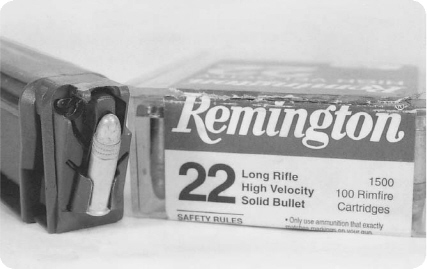
While other ammo also works, I started out with Remington; it never failed, so I didn’t feel any need to switch.
Sharp-eyed readers might note the Advantage Arms conversion does not use a locking block bridge, while the carbine conversion from Mech-Tech does, and ask why not? The carbine conversion fires a centerfire cartridge and uses standard Glock magazines. The barrel can’t tilt, so the bridge covers the gap between the magazine and chamber. The Advantage Arms conversion uses its own magazines, and the magazine is held in the frame so as to feed directly into the chamber of the rimfire barrel.
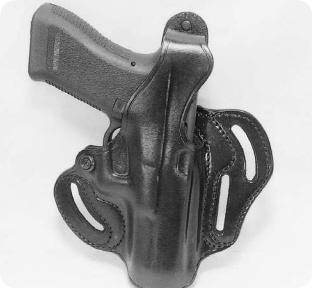
Once assembled, the Advantage Arms conversion works just like a “real” Glock – and even fits holsters like one.
Cleaning is simple, as all the parts are easy to get to and scrub. Rimfire ammo is notorious for being grubby, and the magazine has a drain hole. If it starts to malfunction from being dirty, slosh it in warm soapy water. Use a rod or pencil to cycle the spring and follower up and down, pumping water through the drain hole. Follow with a hot water rinse and dry. Oil lightly to prevent rust.
You will have to work hard to wear out one of these. ![]()